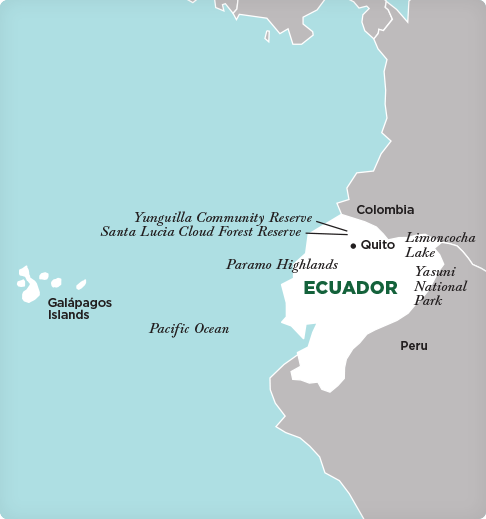Credits
16
Prerequisites
Relevant previous coursework
Language of Study
Spanish
Courses taught in
English
Dates
Aug 30 – Dec 12
Program Countries
Ecuador
Program Base
Quito
Visa
Varies
Critical Global Issue of Study
Climate & Environment

Explore tropical ecosystems, conduct biological fieldwork, and study conservation in one of the world’s most biodiverse countries.
16
Relevant previous coursework
Spanish
English
Aug 30 – Dec 12
Ecuador
Quito
Varies
Climate & Environment
You will live like a biologist as you explore the Amazon basin, the Andes, cloud forests, Pacific Ocean coastline, and the Galápagos Islands of Ecuador—unique climatic niches that harbor ecological treasures and a plethora of flora and fauna. Within these diverse and vulnerable settings, you will conduct biological fieldwork, studying plants and insects, taking soil samples, conducting species counts, using mist nets, and observing birds. You will also have the opportunity to live with two different homestay families: in the capital city of Quito and the rural cloud forest.
See for yourself the importance of Ecuador’s biota as you learn from researchers during excursions to the Andean páramo highlands, the Amazon Region, and the Cloud Forest of North-Western Ecuador. You will also spend a week exploring the Galápagos Islands by land and sea.
Hone the skills you will need to talk about environmental and conservation issues, conduct field research, and engage in institutional and community discussions related to ecology and biology.
Previous college-level coursework or background in environmental sciences, environmental studies, ecology, biology or related fields, as assessed by SIT.
Students studying on this SIT semester-length program can choose to simultaneously complete a minor, with no additional coursework or cost. At SIT, a minor is a minimum of 16 credits taken within a content area. This standout credential can help boost your future job or graduate school applications.
SIT's program in Ecuador offers the choice to do a minor in environmental science or conservation biology. You’ll develop practical skills in biological fieldwork, biodiversity assessment, and apply environmental research methods across Ecuador's four distinct ecosystems—from the Amazon rainforest to the Galápagos Islands—to contribute to conservation solutions in one of the world's most biodiverse countries.


Make a three-day visit to the Andean páramo highlands at Antisana or Chimborazo Reserve and/or other high-altitude reserves. The páramo is a tundra-like ecosystem unique to the neotropics. You will learn about its rare ecology and conservation strategies for coping with human impacts and climate change and protecting endangered species such as the spectacular Andean condor, the largest flying bird on Earth.
On an eight-day excursion to the Cloud Forest, you’ll learn about the ecosystem, field research methods, local environmental movements, and communities living in the region. You will spend five days in Santa Lucia Cloud Forest reserve studying this biodiverse area through ecology field methods and guided hikes. You will also visit Yunguilla Community Reserve and participate in activities such as organic farming, harvesting, processing local products, or cattle ranching, and live with a campesino family for three days.
On this eight-day excursion you will learn about the major human impacts on the natural resource base and biodiversity. Your first three days will be spent around Limoncocha Lake learning about petroleum exploitation and African palm oil plantations in the region. Then you will spend five days at the Tiputini Biological Station in Yasuní National Park or another biological station in the region to learn about rain forest ecology, the ecological characteristics of Amazonia, and methods of monitoring and managing the area’s flora and fauna.
See Darwin’s wonderland during a weeklong excursion to the Galápagos Islands. Half of the week will be spent on a boat with an Ecuadorian naturalist guide working for the National Geographic Society learning about endemic plants, birds, reptiles, and mammals. You will observe geological formations, learn about evolutionary processes, and study the marine habitat through snorkeling, instruction, and observation.
Please note that SIT will make every effort to maintain its programs as described. To respond to emergent situations, however, SIT may have to change or cancel programs.
Upon successful completion of the program, students will be able to:
The following syllabi are representative of this program. Because courses develop and change over time to take advantage of dynamic learning opportunities, actual course content will vary from term to term.
The syllabi can be useful for students, faculty, and study abroad offices in assessing credit transfer. Read more about credit transfer.
Conservation and Sustainability Practices in Ecuador – syllabus
(ENVI3000 / 3 credits)
This course focuses on the analysis of major science-related environmental issues that currently threaten Ecuadorian ecosystems. It provides a multifaceted and interdisciplinary exploration of Ecuadorian conservation and sustainability issues. The course examines contemporary conservation science strategies that have been implemented in order to protect the country’s natural resources and discusses their effectiveness and viability. Through the exploration of Ecuadorian conservation and climate change issues, the course enables students to build an individual framework that facilitates their conceptualization of contemporary environmental issues related to conservation and, as a result, the impact on local resources. The course is conducted mainly in English and encompasses fieldwork activities applying robust science research methods.
Comparative Tropical Ecology – syllabus
(ENVI3005 / 3 credits)
Through a comparative approach, students explore the ecology of each of Ecuador’s four distinct ecological regions: the Andes, the coast, including the North-Western Cloud Forest, the Amazon, and the Galápagos Islands. In each area, students analyze major plant and animal adaptations, the uses of natural resources, and current environmental issues. During field trips, students apply biological and ecological techniques such as quadrants and transects, engage in biological monitoring for plants and animals, and learn to conduct population studies, water (using bio-indicators such as macro-invertebrates) and soils analysis, and other techniques. As part of the course, students visit several sites, including Galápagos National Park, Yasuní National Park, Limoncocha Biological Reserve, Chimborazo or Antisana Andean Reserves, Jerusalem Protected Andean Dry Forest, Santa Lucia Cloud Forest Reserve, Yunguilla Community reserve, among other sites. Coursework is conducted mainly in English.
Spanish for the Natural Sciences I – syllabus
(SPAN2003 / 3 credits)
Spanish for the Natural Sciences II – syllabus
(SPAN2503 / 3 credits)
Spanish for the Natural Sciences III – syllabus
(SPAN3003 / 3 credits)
Spanish for the Natural Sciences IV – syllabus
(SPAN3503 / 3 credits)
In this course, students hone their speaking, reading, and writing skills through classroom and field instruction. They practice reading professional scientific literature as they learn the formal terms and local expressions needed to discuss environmental and conservation issues, to conduct field research, and to interact in institutional and community settings related to the program themes. Students are placed in small classes based on an in-country evaluation that tests both written and oral proficiency.
Environmental Research Methods and Ethics – syllabus
(ENVI3500 / 3 credits)
In this research methods course designed to prepare students for the Independent Study Project, students learn how to organize and conduct a research project. Through lectures, readings, and field activities, students analyze and practice a range of methods appropriate for ecological research including quadrants and transects; biotic sampling; fauna and flora identification; animal behavior; and soil, water (including macro-invertebrates), and light-trap investigation. Students also examine the ethical issues surrounding field research related to ecology and are guided through the World Learning / SIT Human Subjects Review process, which forms a core component of the course. By the end of the course, students will have chosen a research topic, selected appropriate methods, and written a solid proposal for an Independent Study Project related to the program’s focus on ecology. All coursework is conducted mainly in English.
Independent Study Project – syllabus
(ISPR3000 / 4 credits)
Conducted in approved locations around Ecuador, the Independent Study Project offers students the opportunity to implement field research on a topic of their choice within the program’s thematic parameters. The project integrates learning from the various components of the program and culminates in a final presentation and formal research paper. While the ISP can include some social science concepts, the main focus should be biological, ecological, and/or environmental, based upon requests from local NGOs, nature reserves, and local communities.
Sample ISP topic areas:
Browse this program’s Independent Study Projects / undergraduate research.


Students on this program represent a wide array of colleges, universities, and majors. Many of them have gone on to do academic and professional work that connects back to their experience abroad with SIT. Recent positions held by alumni of this program include:
Researcher on ornithological projects at the Jocotoco Foundation, Ecuador
Forestry / carbon sequestration investigator at local NGOs, such as La Hesperia Reserve, Ecuador’s Western Cloud Forest, and EcoMinga Reserve, Ecuador’s Eastern Cloud Forest
Galapagos Conservancy investigator for the Giant Tortoise Restoration Initiative
Science director of the Sumak Kawsay In Situ Reserve at the Amazonian Andean foothills.
DNA sequencing expert at Sumak Kawsay in Situ Reserve
Field technician for the Naomi Pierce Lab at Harvard University, in the Mpala Research Center, Kenya
Camera trap researcher at Saving Species/Saving Nature, an international NGO, including research in Brazil and Ecuador
High school biology teacher in Mozambique
Fulbright and San Francisco University, Quito investigator of Ecuadorian paramo peatlands
Sangay-Podocarpus Connectivity Corridor investigator at University of Montana, International Conservation & Development
Researcher on poison dart frogs with National Geographic Society, Peru
Researcher, National Parks Service, Hawaii


SIT Study Abroad is committed to ensuring that international education is within reach for all students. We believe in the transformative power of immersive, intercultural experiences and are dedicated to supporting students in their educational journey.
See All Costs
A critical step in preparing for your study abroad program is planning how you will maintain your health and wellbeing. Please review the following information carefully and contact [email protected] with any questions or concerns.
Learn More
Depending on your passport of origin, you may need a visa for this program. Please contact your admissions officer for more information.

SIT Ecuador alum Gabriel Oppler shares how his study abroad experience impacted his current career in conservation.
SIT Ecuador alums Mariana Gonzalez Vega, Lenka Doskocil, and Sage Fox advanced their research goals with Fulbright awards and thesis projects.
When SIT Ecuador alum Ella Halbert went on a survey expedition in the Llanganates National Park, she found what looked like seven new species of frogs.
After becoming captivated by Ecuador’s immense, thriving biodiversity on program, SIT alum Zane Libke returned to Ecuador to continue his DNA sequencing fieldwork.
SIT alum Halle Catalina Brown shares her experience exploring the rich biodiversity in Ecuador.